In Pictures: 14 LGA 2011 Coolers For Your Core i7-3000 CPU
Do LGA 2011-based processors really need to be matched up to closed-loop liquid coolers? Not at all. We collected 14 different high-end heat sink kits able to do the job with air. Keep an eye out for our upcoming performance write-up, too!
Gelid GX-7
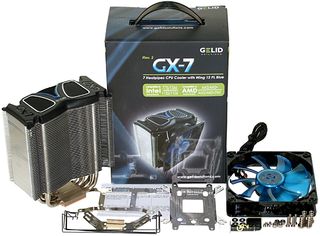
The makers of the famous Tranquillo are deemphasizing previous products in order to focus on their new GX-7, which supports dual fans. Similarities to its previous products lead us to expect similar performance when the unit is only equipped with the one included fan.
Our sample arrived with optional LGA 2011 installation screws that we would hope become part of the updated packaging. Previous-generation Intel interfaces are supported in the original kit, along with AMD’s Socket’s AM2 through AM3+. You can rotate the GX-7 in 90° increments for proper orientation.
Automotive Influence?
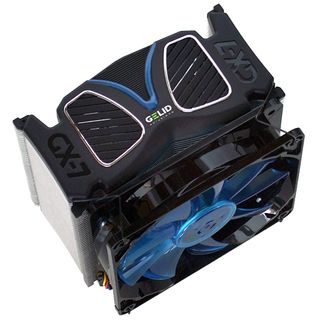
The concave face of the GX-7 directs air down the center of the heat sink’s fins, but the decorative top makes less sense to us. It appears to draw inspiration from a Daewoo automobile’s emblem and side grills.
Gelid adds LED lighting for the GX-7’s fan blades, while the fan frame is opaque.
More Pipe, Less Fin

The GX-7’s dual-fan capability required Gelid to either extend the sides or reduce the center compared to its previous flagship model. Though the compromise seen here results in less surface area, Gelid hopes to recapture some of the lost cooling capacity by adding a fifth heat pipe. The copper mating block is given a finely-machined surface to provide optimal CPU contact.
Noctua NH-D14 SE2011

The performance leader from our previous review returns with this Special Edition LGA 2011 package, differentiated by its extremely narrowly-focused installation kit. Owners of other motherboard types should instead consider the package from our original review.
Teeth And Bumpers
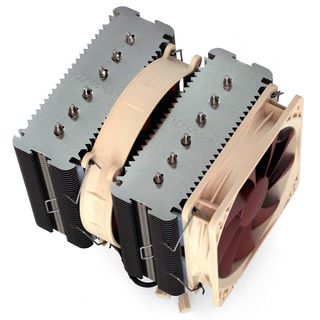
The NH-D14 uses toothed fins to channel air across the entire width of its cooling towers. Nylon noise-dampening strips on each tower fit deeply within side grooves to also act as partial fan shrouds.
Stay on the Cutting Edge
Join the experts who read Tom's Hardware for the inside track on enthusiast PC tech news — and have for over 25 years. We'll send breaking news and in-depth reviews of CPUs, GPUs, AI, maker hardware and more straight to your inbox.
Dual Fans Only

While the NH-D14’s design could support three fans in push-pass-pull configuration, Noctua includes only enough vibration dampeners and clips to support a pair of fans in one orientation. Symmetrical design would allow the cooler to be reversed, but removing the installation screws to flip the entire assembly is easier.
A finely machined copper mating surface spreads heat quickly to six heat pipes.
Phanteks PH-TC14PE
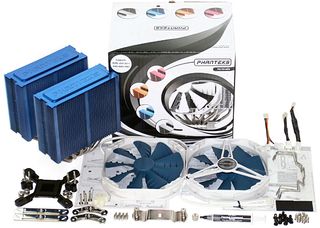
If you found yourself wishing that some of the other dual-tower CPU coolers came with a bit more color and two big fans, the Phanteks PH-TC14PE might be for you. Intel LGA motherboards are supported, and the mounts even allow a proper cross-flow orientation for most AMD platforms.
The twin 140 mm fans are unfortunately of the three-pin (non-PWM) variety. If your motherboard doesn't facilitate fan voltage control, you'll need to either use the bundled in-line resistors or track down a capable third-party controller to adjust speed and noise. A power splitter is included, too.
Color Keyed
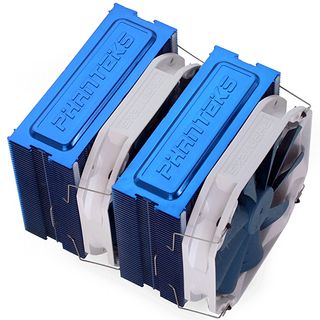
Unlike most competing products, Phanteks coolers are available in several colors to match the theme of your specific build. Silver, orange, red, and blue are all options.
As with most twin-tower coolers, the PH-TC14PE could potentially support up to three fans, but only includes enough clips and dampening strips for two.
Fewer, But Fatter

Five heat pipes connect the PH-TC14PE's cooling towers to its base, but Phanteks oversizes these parts for added capacity. The copper CPU mating surface is finely machined prior to electroplating.
SilenX EFZ-120HA5

Unlike most of the competitors in today’s comparison, SilenX attempts to provide builders with the quietest cooling for each dollar spent, rather than pursuing the most cooling per dollar. The company still had enough faith in its product's cooling capacity to submit this sample for our overclocked Sandy Bridge-E tests.
A traditional installation kit supports Intel’s LGA and AMD’s AM2/3 sockets, and is even designed to point the cooler in the right direction on most AMD motherboards. A second set of screws allows the top bracket’s LGA 1366 holes to mate with the integrated support plate of LGA 2011.
Most Popular






